Illinois is home to several species of squirrels, each with unique features and behaviors. These small mammals are common in forests, parks, and even suburban areas.
The Eastern Gray Squirrel and Fox Squirrel are easily spotted during the day, running along tree branches or foraging on the ground. Red Squirrels are smaller and more energetic, often found in wooded areas.
Flying squirrels are nocturnal and more secretive, gliding silently between trees at night. Knowing how to identify each species helps you appreciate the diversity of squirrels living across Illinois.
Different Types of Squirrels in Illinois
Eastern Gray Squirrel (Sciurus carolinensis)
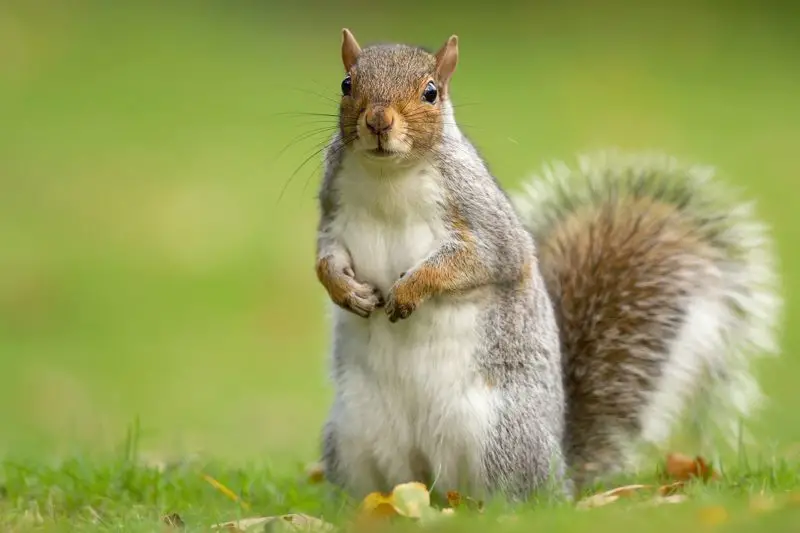
The Eastern Gray Squirrel is Illinois’ most common tree squirrel, easily recognizable by its gray fur that sometimes shows hints of brown. Adults typically measure 9 to 11 inches in body length, with a bushy tail extending another 7 to 10 inches. Their white underbellies and large, dark eyes give them a sharp contrast, making them easy to spot in wooded areas or suburban neighborhoods. Juveniles are smaller and may appear slightly darker, and during winter, their coats become thicker for insulation.
Gray squirrels are agile climbers and often leap between branches with precision. They are diurnal, most active during early mornings and late afternoons. These squirrels build leaf nests called dreys high in tree branches, though they also occasionally take shelter in hollow tree cavities. You might spot them running along power lines or even foraging on the ground, using their excellent memory to retrieve buried nuts.
Their diet consists mainly of nuts, seeds, fruits, and occasionally fungi or tree bark. In Illinois, oak and hickory nuts are favorites, and they are known for caching large amounts of acorns during the fall to last through winter. They sometimes raid bird feeders or compost piles, taking advantage of human food sources. Their habit of burying nuts plays an important ecological role, as many forgotten seeds germinate into new trees.
A fun fact about Eastern Gray Squirrels in Illinois is their seasonal coat changes. In winter, their fur grows longer and denser, and the tail becomes fluffier to serve as a warm wrap during cold snaps. Despite their common presence, they display remarkable intelligence, able to remember hundreds of cache locations and adapt to both urban and rural environments.
Fox Squirrel (Sciurus niger)

Fox Squirrels are the largest tree squirrels in Illinois, measuring 10 to 15 inches in body length with tails that can extend another 10 inches. Their fur ranges from reddish-orange to rusty brown on the back and belly, often with grayish highlights on the back. These squirrels have a long, bushy tail and larger feet compared to gray squirrels, which helps them balance while running along branches or leaping between trees. Their size and coloration make them distinguishable from other local squirrels.
Fox Squirrels are active during the day, especially at dawn and dusk. Unlike gray squirrels, they prefer open woodlands, parklands, and forest edges. They nest in tree cavities but also build leaf dreys, often larger than those of gray squirrels. They are territorial and may chase off smaller squirrels from feeding sites. Their boldness allows them to venture into suburban areas, though they tend to avoid heavily urbanized zones.
These squirrels have an omnivorous diet focused on nuts, seeds, berries, and occasionally insects or small bird eggs. In Illinois, they favor acorns, hickory nuts, and walnuts, often burying them for later retrieval. They are less likely than gray squirrels to raid bird feeders, but they are efficient foragers and can travel long distances to find food sources.
A fun fact about Fox Squirrels in Illinois is their remarkable adaptability to seasonal changes. They store nuts in hundreds of scattered caches and have an excellent spatial memory to locate them months later. Their large size and reddish fur make them stand out in the forest, earning them the nickname “rusty squirrels” among locals.
Red Squirrel (Tamiasciurus hudsonicus)
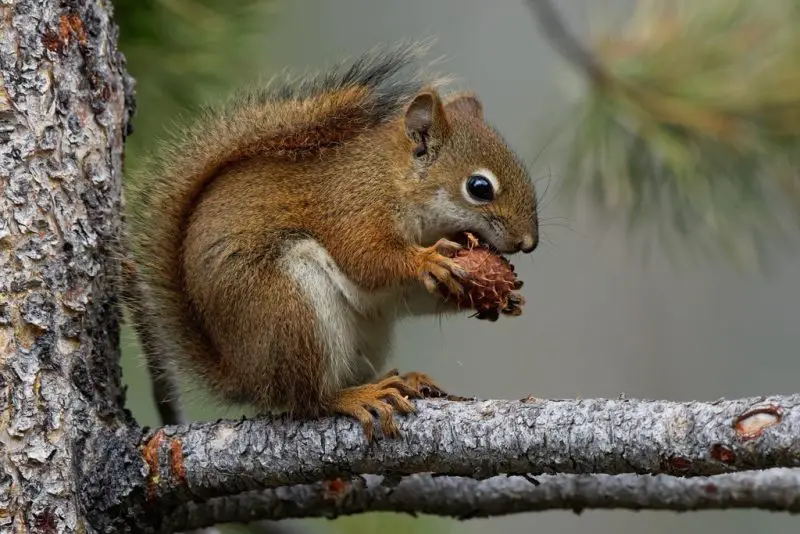
Red Squirrels are smaller than both gray and fox squirrels, averaging 7 to 9 inches in body length with a tail of 5 to 7 inches. Their fur is reddish-brown on the back and sides, with a bright white or cream-colored belly. They have small ears, which may show tufts in winter, and sharp claws that aid in climbing. Their size and color make them easy to identify in coniferous forests, though they are also found in mixed woodlands in Illinois.
Red Squirrels are highly energetic and vocal, often heard before seen. They are diurnal and spend most of their time foraging for seeds and nuts, particularly pine cones. Unlike gray and fox squirrels, they are more aggressive and defend their territories, using loud chattering calls to warn intruders. They build dreys in trees, but in colder months, they may also occupy tree cavities to stay warm.
Their diet is heavily centered on conifer seeds, especially from pine and spruce, but they also eat berries, mushrooms, and occasionally bird eggs. Red Squirrels in Illinois are famous for their scatter-hoarding behavior, where they store seeds in multiple small caches instead of one large one. This strategy reduces the risk of losing all their food to predators or spoilage.
A fun fact about Red Squirrels is that despite their small size, they are among the most aggressive squirrels in Illinois. They can chase away much larger gray squirrels from feeding areas and display remarkable energy and boldness in defending their territory, often making rapid, high-pitched calls that echo through the forest.
Southern Flying Squirrel (Glaucomys volans)
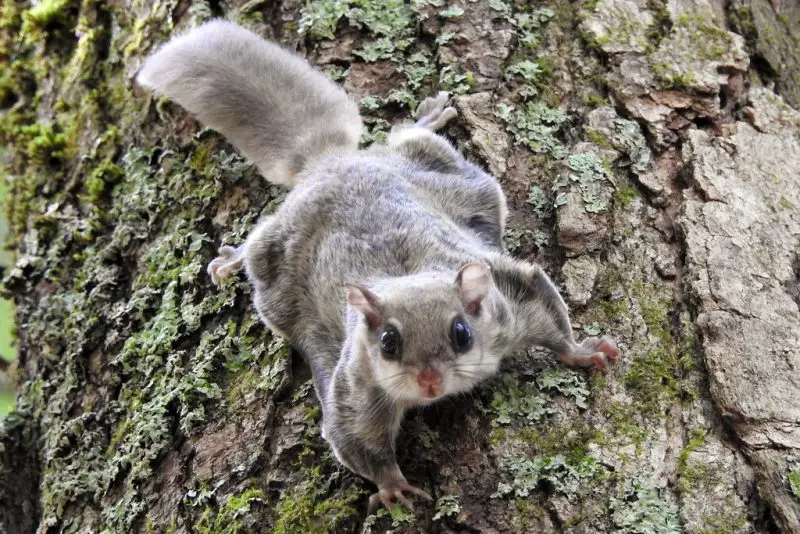
Southern Flying Squirrels are small, nocturnal squirrels measuring 6 to 8 inches in body length, with a 3.5 to 4.5-inch tail. Their fur is soft and gray-brown on top with a pale cream belly. Unlike tree squirrels, they have a membrane called a patagium that stretches between their front and hind legs, allowing them to glide gracefully between trees. These gliding abilities make them unique and fascinating to observe at night.
Being nocturnal, Southern Flying Squirrels are rarely seen during the day. They nest in tree cavities, abandoned woodpecker holes, or birdhouses, and are highly social, often sharing nests during colder months. They are agile and cautious, gliding silently to evade predators. Their vocalizations include soft chirps and squeaks used for communication in the dark.
Their diet is omnivorous, consisting of nuts, seeds, fruits, fungi, and occasionally insects or bird eggs. In Illinois, they commonly feed on acorns, hickory nuts, and beechnuts, storing surplus food in tree cavities or small caches. Their gliding abilities allow them to reach food sources that other squirrels may find difficult to access.
A fun fact about Southern Flying Squirrels is that their glides can cover up to 150 feet in a single leap, controlled precisely by adjusting their tail and limbs. Although small and nocturnal, they play a significant role in forest ecology by dispersing seeds and fungi, contributing to tree regeneration across Illinois woodlands.
Northern Flying Squirrel (Glaucomys sabrinus)

Northern Flying Squirrels are larger than their southern counterparts, averaging 8 to 10 inches in body length with a tail of 4 to 6 inches. Their fur is dense and gray-brown with a paler underbelly. They also have a patagium that enables gliding, though they are less commonly seen in Illinois. Their large eyes are adapted for night vision, helping them navigate the forest under low-light conditions.
These squirrels are strictly nocturnal and prefer mature coniferous and mixed forests, especially those with abundant cavities for nesting. They glide silently between trees, and during winter, they often nest communally in tree cavities to conserve heat. Unlike southern flying squirrels, they are more solitary and secretive, making sightings rare in Illinois.
Their diet focuses on fungi, lichens, seeds, nuts, and occasional insects or bird eggs. They are particularly important for dispersing truffle-like fungi, which have symbiotic relationships with forest trees. This makes Northern Flying Squirrels key contributors to forest health in the regions where they reside.
A fun fact about Northern Flying Squirrels in Illinois is their reliance on old-growth forest patches. Because they are sensitive to habitat disturbance, their presence can indicate healthy forest ecosystems. Their gliding ability and nocturnal lifestyle make them one of the most elusive squirrels in the state, fascinating wildlife enthusiasts who are lucky enough to spot them.
For questions and inquiries about Black Squirrels, you can read the article here.
FAQs About Squirrels in Illinois
What types of squirrels live in Illinois?
Illinois is home to five common squirrel species: Eastern Gray Squirrel, Fox Squirrel, Red Squirrel, Southern Flying Squirrel, and Northern Flying Squirrel. Each species has unique traits, behaviors, and preferred habitats, ranging from urban neighborhoods to mature forests.
How can I tell the difference between a gray squirrel and a fox squirrel?
Gray squirrels are medium-sized with predominantly gray fur and a white belly, while fox squirrels are larger with reddish-orange fur and often a rusty or orange belly. Fox squirrels prefer open woodlands, whereas gray squirrels are commonly found in urban areas and suburban parks.
Are flying squirrels common in Illinois?
Southern Flying Squirrels are present and more common than Northern Flying Squirrels, which are rare in the state. Flying squirrels are nocturnal and glide between trees using a special membrane called a patagium, making them more difficult to spot.
What do squirrels in Illinois eat?
Most squirrels in Illinois eat nuts, seeds, fruits, and occasionally fungi or insects. Eastern Gray and Fox Squirrels favor acorns, hickory nuts, and walnuts, Red Squirrels prefer pine seeds, and flying squirrels consume a mix of nuts, fruits, fungi, and small insects.
Are squirrels in Illinois dangerous to humans?
Squirrels are generally not dangerous, though they can bite if provoked. They can carry ticks or fleas, so it’s best to avoid handling wild squirrels directly. They are mostly a curiosity or garden nuisance rather than a threat.
How do squirrels store food for winter?
Squirrels bury nuts and seeds in scattered caches or store them in tree cavities. Gray and Fox Squirrels are scatter-hoarders, burying nuts in multiple locations, while Red Squirrels often have smaller, more concentrated caches. Flying squirrels store food in nests or cavities.
Can I feed squirrels in my backyard?
Feeding squirrels is possible but should be done carefully. Offer unsalted nuts or seeds sparingly to prevent dependency. Overfeeding can attract too many squirrels, which may lead to damage to gardens or bird feeders.
Do all squirrels live in trees?
While most squirrels are tree-dwellers, they spend a significant amount of time on the ground foraging for food. Flying squirrels glide between trees but rarely descend to the ground unless necessary. Red Squirrels and Fox Squirrels are highly arboreal but will come down for seeds or nuts.
Why are squirrels important to Illinois ecosystems?
Squirrels play a crucial role in forest regeneration by dispersing seeds and nuts. Flying squirrels also help spread fungi, which are vital for soil health and tree growth. Their presence indicates a healthy and balanced ecosystem.
When is the best time to see squirrels in Illinois?
Diurnal squirrels like Eastern Gray, Fox, and Red Squirrels are most active early in the morning and late afternoon. Flying squirrels are nocturnal, so nighttime observation with a flashlight or at known nesting sites is the best way to see them.

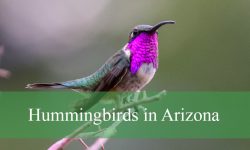


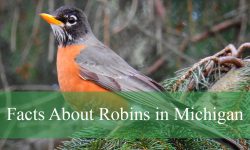

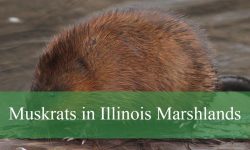
What about Black Squirrels? I have black squirrels by my home. I live in Illinois. Why is there no mention of this?
Hello,
Black squirrels are a melanistic color variant of the eastern gray squirrel or fox squirrel.
You can read more at this artice: https://ownyardlife.com/discover-the-mystery-behind-black-squirrels-in-michigan/
I have black squirrels
yes, It is a variant of the eastern gray squirrel or fox squirrel.